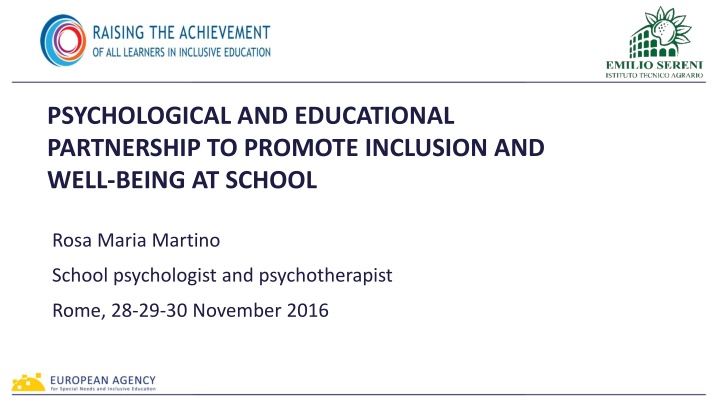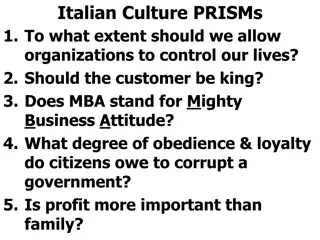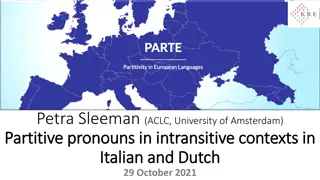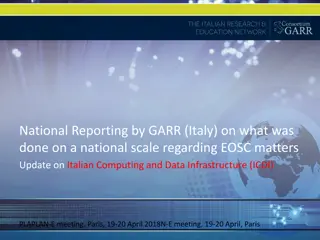
Promoting Inclusion and Well-Being at School through Psychological and Educational Partnership
Explore the partnership between psychology and education to foster inclusion and well-being at Rosa Maria Martino School in Rome. Learn about creating an inclusive educational system, analyzing specific challenges, managing complexities, and bridging the gap between real and ideal schools through collaborative efforts and a common educational language.
Download Presentation

Please find below an Image/Link to download the presentation.
The content on the website is provided AS IS for your information and personal use only. It may not be sold, licensed, or shared on other websites without obtaining consent from the author. If you encounter any issues during the download, it is possible that the publisher has removed the file from their server.
You are allowed to download the files provided on this website for personal or commercial use, subject to the condition that they are used lawfully. All files are the property of their respective owners.
The content on the website is provided AS IS for your information and personal use only. It may not be sold, licensed, or shared on other websites without obtaining consent from the author.
E N D
Presentation Transcript
PSYCHOLOGICAL AND EDUCATIONAL PARTNERSHIP TO PROMOTE INCLUSION AND WELL-BEING AT SCHOOL Rosa Maria Martino School psychologist and psychotherapist Rome, 28-29-30 November 2016
The essential function of the school (1) In an ideal school, to include means: to create an educational system capable of ensuring the right to education for all. Educational system should be based on this inclusive approach to meet every kind of educational need.
The essential function of the school (2) How to make the real ideal ? Analysing the specific problem Considering the specific situation SOLUTIONS will be provided based on its potential
The environment (1) In a real context, this means an intervention which considers DIFFERENT SUBJECTS WITH DIFFERENT NEEDS AND REQUESTS: Students Families Teachers Headmaster Other School Professionals Extra Professionals
The analysis of the environment How to manage this complexity? Schools can manage it by building a FUNCTIONAL ORGANIZATION of each component of the system: People (i.e. students, teachers, ) Environment Relationships
The gap between the real school and the ideal school (1) Considering our specific situation, complexity derives from: High number of students with disabilities High number of students with severe disabilities (Autism, mental diseases, genetic diseases, etc.) High number of students with Specific Learning Disorders High number of students with no certified disabilities
The gap between the real school and the ideal school (2) HOW TO BALANCE THIS COMPLEXITY TO CREATE WELLBEING? It s necessary to create psycho-educative and social partnerships And a common educative language
The environment (2) The ideal school The real school This complex system, made by many actors and different situations, generates a gap between the ideal and the real
The functional response from school Through the creation of psychoeducational and social alliances, among three constant, current, synergic dimensions: Contexts Actions Experiences
Three different dimensions In a SHARED LEADERSHIP APPROACH that aims to strengthen the motivation and create an atmosphere of positive interdependence in a context that applies democracy as a value and as a method.
The possible answers CONTEXTS Class / Didactic: Cooperative Learning, Peer Tutoring, Learning by doing School / Organisation: Distributed Leadership, Department (inclusion and others), the Operative Working Group on Disability (GLHO), the Working Group for Inclusion (GLI) Family / Co-responsibility: Family involvement Community: School-work alternation
Answers: the quality of life Psycho-educational and social partnership with a deep attention on relationships between COMMUNITY LEADERSHIP TEACHING - LEARNING PROCESS STAFF = Naturally distributed leadership, mutual responsibility
The quality of life Through this perspective: Students Parents Educational operators inside/outside the school Headmaster Feel ACCEPTED, APPRECIATED, RESPECTED, ESTEEMED DEMOCRACY is proposed as a VALUE and is perceived as a METHOD!
The quality of life at school (1) Such an approach, centred on health, focuses on the potential of each and starting from the INDIVIDUAL strengths, aims to promote the well-being and the quality of life through the creation of a COMMON LANGUAGE
The quality of life at school (2) OUR AIM IS TO SPREAD A COMMON LANGUAGE THROUGH GOOD PRACTICES AND CORRECT BEHAVIOUR for the well-being at school AND FULL INVOLVEMENT OF ALL THE SCHOOL HEADMASTER, as a legal representative of the school, IS A SUPERVISOR AND A COACH focused on recruiting, hiring, developing, Evaluating THE WHOLE SCHOLASTIC COMMUNITY
Leadership for learning Instructional Leadership + Transformational Leadership LEADERSHIP FOR LEARNING (Hallinger, 2011; Leithwood, Harris, Hopking, 2008)
Inclusive school Instructional leadership is learning focused, learning for both students and adults, and learning which is measured by IMPROVEMENT in instruction for all students, INSIGHT MOTIVATION for the workforce and BETTER QUALITY of SCHOLASTIC LIFE. A culture of PUBLIC PRACTICE and REFLECTIVE PRACTICE is essential for effective instructional leadership and the improvement of instructional practice. Instructional leadership addresses the cultural, linguistic, socio-economic and learning diversity in the school community.
A new approach focused on well-being A biopsychosocial model to promote prevention and wealth focused on Roger's view of the fully functioning person and on ICF Model The six key dimensions of psychological well-being (RYFF, 1966) 1. Autonomy 2. Environmental mastery 3. Personal growth 4. Positive relationships 5. Self-acceptance 6. Purpose in life






















